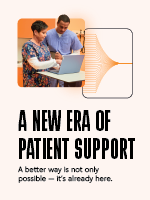Today’s guest post comes from Megan Marchal, Director of Specialty Strategy at CoverMyMeds.
Megan shares the story of Don, a cancer patient who struggled to access and afford his medications. She describes how human care plus an innovative, technology-driven patient support solution can help patients start therapy and get on the road to recovery.
To learn more about CoverMyMeds’ specialty therapy solutions, visit Booth 1519 at Asembia's Specialty Pharmacy Summit in Las Vegas, April 30-May 4, 2023. Additionally, sign up for CoverMyMeds’ on-site recaps from the summit.
Read on for Megan’s insights.
Pages
▼
Friday, April 28, 2023
Tuesday, April 25, 2023
Drug Channels News Roundup, April 2023: OptumRx’s Biosimilar Nonsense, Accumulator Inequity, Amazon Redux, AFPs, and My Meeting with Mark Cuban
Baseball season is here! While we wait for the Phillies turnaround, let’s oil up our gloves, lace up our cleats, and run the bases around this month's biggest hits:
P.S. Join my nearly 41,000 (!) LinkedIn followers for daily links to neat stuff. You can also find my daily posts at @DrugChannels on Twitter, where I have more than 16,000 followers. (I recommend that you follow me on LinkedIn, because the quality of comments is much, much higher than they are on Twitter.)
- Foul ball: OptumRx prefers higher prices for the first Humira biosimilar (SEE UPDATE BELOW)
- Strikeout: Copay accumulators hurt health equity
- Bench warmer: Surprise? Amazon has still not disrupted healthcare
- Spitting mad: Shady alternative funding programs (AFPs) face more scrutiny
P.S. Join my nearly 41,000 (!) LinkedIn followers for daily links to neat stuff. You can also find my daily posts at @DrugChannels on Twitter, where I have more than 16,000 followers. (I recommend that you follow me on LinkedIn, because the quality of comments is much, much higher than they are on Twitter.)
Friday, April 21, 2023
Prescribers More Likely to Choose Brands with Automated Processes for Buy-and-Bill Copay Assistance
Today’s guest post comes from Ticia Cawley, VP of Client Solutions at ConnectiveRx.
Ticia reviews four interim findings from ConnectiveRx's survey of buy-and-bill prescribers and their support staff. The survey reveals new insights about how practices evaluate automation and digital tools for provider-administered specialty therapies.
To learn more, register for ConnectiveRx’s free online panel discussion on May 17th at 1:00 p.m. ET: Automation and Ease: The Future of Buy-and-Bill. Ticia will be joined by a buy-and-bill brand leader and a medical professional.
Read on for Ticia’s insights.
Ticia reviews four interim findings from ConnectiveRx's survey of buy-and-bill prescribers and their support staff. The survey reveals new insights about how practices evaluate automation and digital tools for provider-administered specialty therapies.
To learn more, register for ConnectiveRx’s free online panel discussion on May 17th at 1:00 p.m. ET: Automation and Ease: The Future of Buy-and-Bill. Ticia will be joined by a buy-and-bill brand leader and a medical professional.
Read on for Ticia’s insights.
Tuesday, April 18, 2023
The Inflation Reduction Act: 10 Predictions About Market Access and Drug Channels
Like it or not, the Centers for Medicare & Medicaid Services (CMS) is barreling ahead with its implementation of the Inflation Reduction Act of 2022 (IRA). Last Friday was the last day to submit comments on CMS's initial guidance on the drug price negotiation program.
The IRA will alter many crucial aspects of the Medicare program and the overall drug channel. To help you anticipate what’s ahead, below I highlight 10 predictions on how the IRA will impact drug prices, demand for prescription drugs, Part D plan strategies, rebates, manufacturers’ revenues, retail pharmacies, and more.
While this is a longer-than usual post, I can still only barely scratch the surface of the many far-reaching effects of this legislation. As always, I encourage you to share your own thoughts in the comments below or on social media.
The IRA will alter many crucial aspects of the Medicare program and the overall drug channel. To help you anticipate what’s ahead, below I highlight 10 predictions on how the IRA will impact drug prices, demand for prescription drugs, Part D plan strategies, rebates, manufacturers’ revenues, retail pharmacies, and more.
While this is a longer-than usual post, I can still only barely scratch the surface of the many far-reaching effects of this legislation. As always, I encourage you to share your own thoughts in the comments below or on social media.
Friday, April 14, 2023
Digital Transformation: Facilitating Healthcare Provider and Patient Behavior Change
Today’s guest post comes from Edward Hensley, Chief Commercial Officer at AssistRx.
Edward discusses how a technology-first approach automates manual processes for therapy initiation. He argues that such an approach can increase patient adherence, speed access to therapy, and improve the healthcare providers’ workflow.
To learn about AssistRx’s technology-first solutions, click here to schedule a meeting at Asembia’s Specialty Pharmacy Summit.
Read on for Edward’s insights.
Edward discusses how a technology-first approach automates manual processes for therapy initiation. He argues that such an approach can increase patient adherence, speed access to therapy, and improve the healthcare providers’ workflow.
To learn about AssistRx’s technology-first solutions, click here to schedule a meeting at Asembia’s Specialty Pharmacy Summit.
Read on for Edward’s insights.
Wednesday, April 12, 2023
DCI’s Top 15 Specialty Pharmacies of 2022: Five Key Trends About Today’s Marketplace
In Drug Channels Institute’s list of the top 15 pharmacies of 2022, we show that central-fill, mail pharmacies operated by large PBMs and health insurers have displaced retail chains as the largest prescription drug dispensers by revenues.
To complement that broader ranking, we rummaged around our DreamHouse to update our exclusive list of the top 15 pharmacies based on specialty drug dispensing revenues in 2022.
For 2022, pharmacy benefits managers (PBMs) and insurers expanded their dominance over specialty dispensing, though both hospitals and physician practices are growing their share of the market. The top three PBM-owned specialty pharmacies accounted for nearly two-thirds of prescription revenues from pharmacy-dispensed specialty drugs. As predicted last year, Walgreens’ specialty pharmacy business has collapsed, which led to a slightly less concentrated industry.
Read on for additional observations about hospitals, independent pharmacies, the dynamics that created this market structure, and why life in plastic is fantastic.
To complement that broader ranking, we rummaged around our DreamHouse to update our exclusive list of the top 15 pharmacies based on specialty drug dispensing revenues in 2022.
For 2022, pharmacy benefits managers (PBMs) and insurers expanded their dominance over specialty dispensing, though both hospitals and physician practices are growing their share of the market. The top three PBM-owned specialty pharmacies accounted for nearly two-thirds of prescription revenues from pharmacy-dispensed specialty drugs. As predicted last year, Walgreens’ specialty pharmacy business has collapsed, which led to a slightly less concentrated industry.
Read on for additional observations about hospitals, independent pharmacies, the dynamics that created this market structure, and why life in plastic is fantastic.
Friday, April 07, 2023
Key Trends in Medical Benefit Contracting and Value-Based Agreements
Today’s guest post comes from Heather Roulston, Market Research Manager at MMIT.
Using MMIT’s proprietary data, Heather demonstrates that contracting for medical benefit drugs is now common for many therapeutic areas. She then highlights how manufacturers and payers are adopting value-based agreements (VBA) for medical benefit products—although VBA usage varies widely across therapeutic area. Heather also shares data on payers’ site-of-care management strategies.
For additional market insights, click here to learn about MMIT’s Biologics & Injectables Index.
Read on for Heather’s insights.
Using MMIT’s proprietary data, Heather demonstrates that contracting for medical benefit drugs is now common for many therapeutic areas. She then highlights how manufacturers and payers are adopting value-based agreements (VBA) for medical benefit products—although VBA usage varies widely across therapeutic area. Heather also shares data on payers’ site-of-care management strategies.
For additional market insights, click here to learn about MMIT’s Biologics & Injectables Index.
Read on for Heather’s insights.
Tuesday, April 04, 2023
Four Trends That Will Pop the $250 Billion Gross-to-Net Bubble—and Transform PBMs, Market Access, and Benefit Design
Time for Drug Channels Institute’s annual update on the gross-to-net bubble—the ever-growing dollar gap between sales at brand-name drugs' list prices and their sales at net prices after rebates and other reductions.
We estimate that the gross-to-net bubble reached $223 billion for patent-protected brand-name drugs in 2022. If we include brand-name drugs that have lost patent protection and face competition from generic equivalents, the bubble was even higher, at $256 billion. Our latest data appear below.
Four crucial trends will deflate the gross-to-net bubble—thereby disrupting market access strategies, altering pharmacy benefit manager (PBM) profit models, and changing plan sponsor benefit designs. Perhaps it’s time to get ready for the day when SpongeBob SquarePants will depart from Drug Channels.
We estimate that the gross-to-net bubble reached $223 billion for patent-protected brand-name drugs in 2022. If we include brand-name drugs that have lost patent protection and face competition from generic equivalents, the bubble was even higher, at $256 billion. Our latest data appear below.
Four crucial trends will deflate the gross-to-net bubble—thereby disrupting market access strategies, altering pharmacy benefit manager (PBM) profit models, and changing plan sponsor benefit designs. Perhaps it’s time to get ready for the day when SpongeBob SquarePants will depart from Drug Channels.







